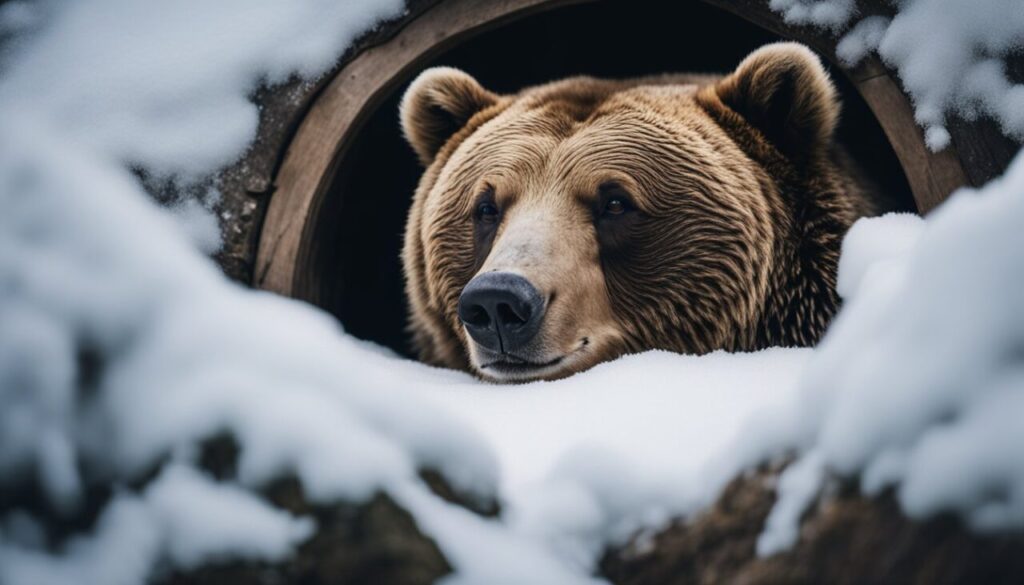
You’ve surely thought at least once in your life how you’d prefer to switch to hibernation mode. You know those cold and gloomy winter days when it seems like nothing is right? The days when you’d prefer them to pass and wake up in a few months in sunny spring.
Well, currently we don’t have this ability. However, is this a real possibility in the future?
Let’s see.
Hibernation is the ability to slow down the body’s functions and survive long periods of time without food or water. It is a characteristic that is commonly found in many species of animals, including bears, bats, and even some primates.
But as mentioned – not humans. We didn’t evolve in such a way that we needed hibernation. We always found ways to find food even in harsh winters.
And so – why would we even need hibernation, especially now in modern times?
Well, the concept of human hibernation is actually not new.
Namely, there are several reasons why humans might benefit from hibernation. For one, it could be used to help astronauts endure long space missions, as well as to help patients with certain medical conditions.
And so, let’s explore this concept in more detail.
Interesting fact: Some researchers believe that hibernation could also be used to slow down the aging process, as well as to help humans survive in extreme environments such as Antarctica or the deep sea. However, there are still many challenges that need to be overcome before human hibernation can become a reality.
Understanding Hibernation

Biological Mechanisms of Hibernation
Hibernation is a state of reduced metabolic activity that allows certain animals to survive during periods of extreme cold or food scarcity. This state is achieved through a complex interplay of physiological and biochemical mechanisms.
One of the key features of hibernation is a decrease in body temperature. This is achieved through a combination of behavioral and physiological adaptations. For example, some hibernators will seek out sheltered areas where they can conserve heat, while others will decrease their metabolic rate to reduce heat production.
Another important aspect of hibernation is the ability to conserve energy. This is achieved through a variety of mechanisms, including a decrease in heart rate and respiration, as well as a reduction in physical activity. Additionally, hibernators are able to recycle waste products, such as urea, to further conserve energy.
Interesting fact: Some hibernators, such as the Arctic ground squirrel, are able to reduce their metabolic rate by as much as 95% during hibernation.
Natural Hibernators in the Animal Kingdom
Hibernation is a common adaptation among many different animal species. While most people are familiar with hibernating mammals, such as bears and hedgehogs, many other types of animals also enter a state of hibernation.
For example, some amphibians and reptiles are able to enter a state of torpor, which is similar to hibernation. During torpor, these animals will reduce their metabolic rate and become less active.
Insects are another group of animals that are capable of hibernation. Some species, such as the monarch butterfly, will migrate to warmer climates during the winter months, while others, such as the woolly bear caterpillar, will enter a state of diapause, which is similar to hibernation.
And so, as mentioned, some animals hibernate longer than others.
For example:
| Animal | Habitat | Hibernation Period |
| Brown Bear | Forests | 5-7 months (depending on climate) |
| Groundhog | Fields and forests | 3-5 months |
| Hedgehog | Gardens and parks | 3-4 months |
| European Dormouse | Woodlands | 6-7 months |
| Bats | Caves and trees | 3-6 months |
| Arctic Ground Squirrel | Tundra | 7-9 months |
| Alpine Marmot | Mountainous regions | 5-6 months |
| Fat-tailed Dwarf Lemur | Madagascar | 7-8 months |
| Black Bear | Forests | 3-8 months (depending on climate) |
| Chipmunk | Woodlands | 4-5 months |
| Common Poorwill | North America | 3-9 months |
Interesting fact: The longest recorded hibernation period for a mammal was 367 days, achieved by the Australian eastern pygmy possum.
Okay, now that we know most animals that hibernate, let’s explore why humans don’t have this ability.
Human Hibernation Possibilities

Comparative Physiology
One key difference between humans and hibernating animals is our metabolism. Hibernating animals are able to lower their metabolic rate significantly, which allows them to survive for extended periods without food or water. Humans, on the other hand, have a higher metabolic rate, which means we need to consume more energy to stay alive.
Another difference is body temperature. Hibernating animals can lower their body temperature by several degrees, which helps them conserve energy. On the other hand, humans have a tightly regulated body temperature that is essential for many bodily functions, such as enzyme activity and immune system function.
Interesting fact: Some species of hibernating animals, such as the Arctic ground squirrel, can reduce their heart rate to just a few beats per minute during hibernation.
Challenges in Human Hibernation
Even if it were possible for humans to hibernate, there are several challenges that would need to be overcome. One major challenge is the risk of hypothermia. Humans are not adapted to survive at low body temperatures, and prolonged exposure to cold could be fatal.
Another challenge is the potential damage to vital organs. Hibernating animals are able to slow down their bodily functions to protect their organs, but it is unclear whether this would be possible in humans.
Finally, there is the issue of waking up from hibernation. Hibernating animals have evolved to wake up naturally when conditions improve, but it is unclear whether humans would be able to do so.
Nonetheless, scientists are constantly researching the potential for some kind of human hibernation. In the next section, we’ll explore why.
Interesting fact: Some scientists believe that studying hibernation in animals could lead to new treatments for human diseases, such as Alzheimer's and Parkinson's.
Current Research and Developments

Advancements in Cryonics
Cryonics is the process of freezing a human body with the hope of reviving it in the future. While the technology is still in its early stages, there have been some recent advancements in cryonics research. One of the most significant developments is the use of vitrification instead of traditional freezing methods. Vitrification involves replacing the body’s fluids with a type of antifreeze that prevents ice crystals from forming. This method has shown promise in preserving tissue and organs, which could be crucial for successful human hibernation.
Interesting fact: The first person to be cryogenically frozen after death was Dr. James Bedford. He was a psychology professor at the University of California, and upon his death on January 12, 1967, he became the first person to undergo cryopreservation. His body was placed in a cryonic suspension at the Alcor Life Extension Foundation in Arizona, USA.
Space Travel and Hibernation Studies
NASA has been studying the effects of hibernation on astronauts during long-duration space travel. The idea is that if humans could hibernate, they could potentially travel long distances in space without the need for large spacecraft or life support systems. Studies have shown that inducing torpor, a state of reduced metabolic activity similar to hibernation, can significantly reduce the amount of food, water, and oxygen needed to sustain an astronaut. However, there are still many unknowns about the long-term effects of hibernation on human physiology.
Potential Benefits of Human Hibernation

Medical Applications
Human hibernation has the potential to revolutionize medicine by allowing doctors to place patients in a state of suspended animation during surgeries or medical emergencies. This could be especially beneficial for patients who are critically ill or require a complex surgery that would otherwise be too risky. The process of hibernation would allow doctors to slow down the body’s metabolism and reduce the need for oxygen, which could help prevent tissue damage and improve outcomes.
Additionally, hibernation could be used to treat certain medical conditions such as stroke, traumatic brain injury, and cardiac arrest. By placing a patient in a state of hibernation, doctors could slow down the body’s metabolic rate, reducing the amount of damage caused by these conditions and increasing the chances of a full recovery.
Interesting fact: Scientists have successfully induced hibernation in non-human animals such as bears, squirrels, and even some primates.
Can Drugs Induce Hibernation in Humans?

While hibernation is a natural process for some animals, it is not for humans. However, researchers have been exploring the possibility of inducing hibernation in humans for long-duration space travel or medical purposes. One approach that has been studied is the use of drugs to induce hibernation-like states in humans.
Scientists have identified certain molecules that can induce torpor, a state of reduced metabolic activity similar to hibernation, in animals. One such molecule is Hydrogen Sulfide (H2S), which has been shown to induce torpor in mice. Researchers have also studied the effects of other molecules such as adenosine, melatonin, and cannabinoids on inducing torpor in animals.
However, the use of these molecules to induce torpor in humans is still in its early stages of research. There are concerns about the safety and effectiveness of using these molecules in humans, particularly over long periods of time. Additionally, the molecular mechanisms that regulate torpor in animals are not fully understood, making it difficult to predict the effects of these molecules on humans.
Interesting fact: Hydrogen Sulfide (H2S) is a toxic gas that smells like rotten eggs. However, in low concentrations, it has been shown to have therapeutic effects on various diseases and conditions.
Future Prospects and Conclusions

While the idea of human hibernation may seem like something out of science fiction, recent research has shown that it may be a possibility in the future. However, there are still many challenges that need to be overcome before humans can safely and effectively enter hibernation.
One of the biggest challenges is figuring out how to induce and maintain hibernation without causing harm to the human body. Another challenge is developing technology that can monitor and regulate the body during hibernation to prevent complications.
Despite these challenges, there is hope that humans may one day be able to hibernate. The potential benefits, such as reduced metabolic needs during space travel or medical procedures, make it an area of research worth pursuing.
Conclusion

In conclusion, the question of whether humans could ever hibernate remains semi-unanswered. While there have been some promising studies and experiments on inducing torpor in humans, there are still many challenges to overcome before hibernation can become a viable option for humans.
One of the biggest challenges is the metabolic changes that occur during hibernation. These changes can lead to a buildup of toxic byproducts in the body, which could be harmful if not properly managed. Additionally, the long-term effects of hibernation on human health are still unknown.
Nonetheless, we could say that hibernation will be possible in the future. Will it happen in 2050 or 2100, we can not know, but most certainly, some kind of hibernation will be possible.
Some people will hibernate because of diseases or because of business travel, and perhaps some people will hibernate just because they can.
Probably, in the next 30 years, hibernation will become easily available as headache pills today.
If we’re alive in 30 years, we’ll come back to this article to see if our prediction holds any grounds.
And then perhaps, we’ll hibernate.



























